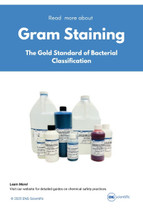Aug 6th 2025
Gram Staining: The Gold Standard of Bacterial Classification
In the fast-paced era of laboratory diagnosis, some procedures have not just survived the test of time, they've become the bedrock. One such procedure is the Gram stain, the cornerstone of microbiology that remains essential even in an age dominated by automated diagnostic platforms and gene sequencing.
Utilized over one hundred years, the Gram stain is still a rapid, cost-effective, and stable reagent to differentiate bacterial species based on the type of their cell walls. Whether in the clinical microbiology laboratory, research laboratory, or instruction lab, it is still an invaluable first step towards the identification of infectious agents.
At EngScientific, we understand how important consistency, precision, and ease are to every laboratory protocol. To that end, we offer higher-quality Gram stain reagents and kits intended to fit high-throughput diagnostic environments as well as single-purpose academic research purposes. We aim to enable precision and replicability in every laboratory, regardless of size.
Understanding the Gram Stain Process
The Gram stain was invented in 1884 by Danish microbiologist Hans Christian Gram and is still one of the most widely used staining techniques worldwide. The Gram stain separates bacteria into two large categories: Gram-positive and Gram-negative. This is done on the basis of the cell wall's structure and composition in bacteria.
Gram-positive bacteria have a heavy peptidoglycan layer that holds the primary dye, crystal violet, even if a decolorizer is employed, e.g., ethanol or acetone. The cells will thus be purple when viewed under a microscope. Gram-negative bacteria have a light peptidoglycan layer and an outer membrane, which do not trap the crystal violet dye. These cells are stained red or pink by the counterstain, safranin.
The fundamental four-step process of Gram staining:
-
- Application of the crystal violet (primary stain)
- Application of iodine (mordant)
- Alcohol wash (decolorization)
- Application of safranin (counterstain)
This process, although straightforward, yields essential information that can inform early diagnosis and therapeutic decision-making. In most instances, clinicians initiate empiric antibiotic therapy on the basis of Gram stain findings pending culture confirmations.
Even with the progress in molecular diagnostics and real-time PCR technologies, Gram staining remains valuable due to its rapidity, cost-in-effectiveness, and consistency. For clinical microbiology, it provides an immediate preliminary identification method, particularly for emergent conditions like meningitis, sepsis, or pneumonia. As a sample like cerebrospinal fluid, sputum, or blood is stained and looked at, the morphology and staining characteristics can provide important early hints.
Additionally, Gram staining is essential in quality control, research use, and studies of the environment. It is regularly used to confirm culture purity or screen for bacterial contamination in pharmaceutical and industrial settings.
Applications in Various Industries
Although Gram staining is most commonly linked with medicine and medical microbiology, it has more extensive applications than many are aware of:
-
- Pharmaceutical production employs Gram staining to screen microbial contamination in sterile conditions.
- Food and drinks industries use it for quality control and microbial safety.
- Gram staining is used in veterinary medicine for detecting pathogens of diseases in animals.
- Gram staining is employed in educational institutions and research labs to instruct students on microbiology basics or for experiments on microbial physiology and genetics.
All these industries need the reliability of staining reagents and method. That is where your Gram stain kit quality is all that counts.
Select EngScientific for Consistent Gram Stain Kits
EngScientific has high-performance Gram stain solutions that labs around the country rely on for their stability, clarity, and batch-to-batch consistency. If you require individual reagents such as crystal violet, Gram iodine, decolorizer, or safranin, or if you prefer a convenient complete ready-to-use kit, we have solutions tailored to your workflow.
We are also proud to ensure that our products are compatible with a wide variety of staining systems. From manual staining configurations to semi-automatic systems, our reagents are designed for optimal staining accuracy and shelf life.
Discover our Gram Stain products here:
EngScientific Gram Stains
How to Optimize Gram Stain Accuracy
For users working with Gram stain methods on a regular basis, the following are some best practices to ensure reproducible, accurate results:
-
- Use freshly prepared cultures (18–24 hours old) where possible.
- Do not over-decolourise, or Gram-positive cells may be given a Gram-negative appearance.
- Standardise the staining time for each stage, uniformity is everything.
- Work on grease-free, clean slides to prevent artefacts or patchy staining.
- Regularly check reagent quality for deteriorated or out-of-date dyes.
If used properly, Gram staining can deliver masses of information within minutes, a benefit which no lab can afford to ignore.
Conclusion
Gram staining is more than a laboratory tradition, it's a cheap, quick, and effective method that still remains the hub of bacterial identification. With new technology emerging, Gram stain is one of the only methods that still connects traditional microbiology to current diagnostics.
With EngScientific's technical support and premium reagents, your laboratory is poised for producing consistent, clear, and repeatable Gram stain results every time. Whether you use Gram staining for daily testing or teaching the next generation of microbiologists, Gram staining will be a staple of your lab routine.

